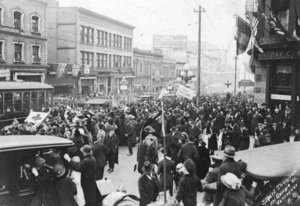Armistice of 1918
There are many intriguing lesser-known facts about the Armistice of 1918.
The conditions of the signing of the armistice are often not as well-known as its aftermath. The armistice was signed from 5 - 5:20 AM on November 11th, 1918. The signatories from Allied and German powers met inside a train car that had been repurposed as a negotiation room while travelling through a forested area near Compiegne, France. After the war, this train car was returned to the approximate location of the signing, and a commemorative memorial called the “Glade of the Armistice” was created around it. Eventually, Adolph Hitler would use this location to receive the surrender of France due to its significance. The original train car and memorial were destroyed during WW2, but after the end of the war both were reconstructed.
An armistice may bring an end to the violence of war and allow two groups to coexist, but it does not formally instate peace. The armistice signed on November 11 was actually reinstated four separate times, until formal peace was reached at the Paris Peace Conference of 1919. This conference had world-changing effects: it led to the creation of the League of Nations, divided up and transferred territories, created new countries, and established basic principles of international relations - for good and for ill.
Many people wonder how the armistice was received on the front lines. While a ceasefire was widely anticipated in the days leading up to the 11th, official notice did not reach all divisions as quickly as one would hope. The Americans’ 157th brigade was only notified of the time that the armistice came into effect 16 minutes before 11 AM that day, and they continued fighting until the last possible moment. This division resulted in the final casualty of the war. An American of German descent named Henry Gunther was killed at 10:59 AM. Controversially, some military leaders saw the time between the signing of the armistice and the time it came into effect as their last opportunity to fight their enemy. As a result, thousands of soldiers died that morning.
The many tales and lesser-known facts of the Armistice of 1918 serve as a reminder of the human cost of war and compel us to strive for peace.
Photo Credit: City of Vancouver Archives AM54-S4-: Mil P14.2 Major James Skitt Matthews [Armistice day procession on Granville Street at Georgia Street]

